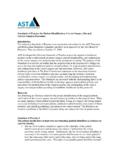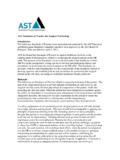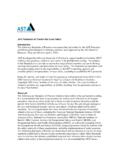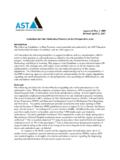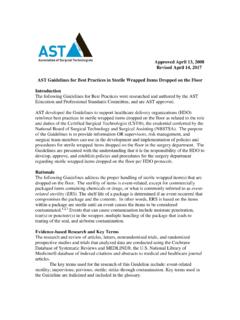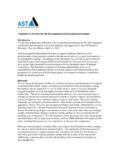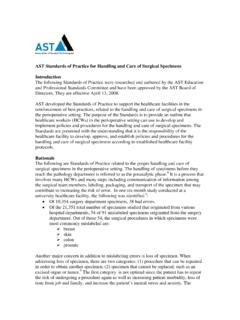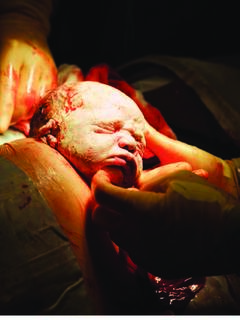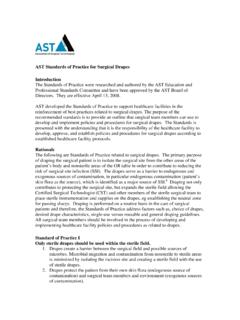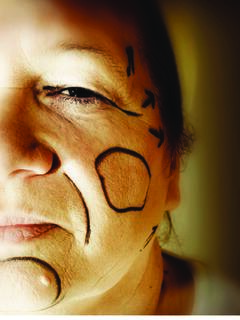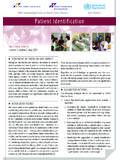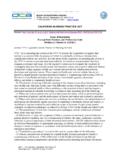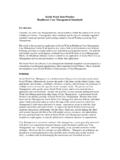Transcription of Standard Skin Prep
1 AST standards of practice for skin prep of the Surgical Patient Introduction The following standards of practice were researched and authored by the AST Education and Professional standards Committee and have been approved by the AST Board of Directors. They are effective October 20, 2008. AST developed the standards of practice to support healthcare facilities in the reinforcement of best practices related to the patient skin preparation (henceforth in this document referred to as the skin prep ) in the perioperative setting.
2 The purpose of the Recommended standards is to provide an outline that surgical team members can use to develop and implement polices and procedures for skin prep . The standards are presented with the understanding that it is the responsibility of the healthcare facility to develop, approve, and establish policies and procedures for skin prep according to established healthcare facility protocols. Rationale The following are standards of practice related to skin prep in the perioperative setting. The skin prep is part of the daily patient care routine of the Certified Surgical Technologist (CST) and Certified Surgical First Assistant (CSFA) in the OR.
3 The majority of surgical site infections (SSIs) are caused by the entry of the patient s own microbial flora into the surgical wound. Since the patient s skin cannot be sterilized, skin prep is performed. skin prep aids in preventing SSIs by removing debris from, and cleansing, the skin , bringing the resident and transient microbes to an irreducible minimum, and hindering the growth of microbes during the surgical All surgical team members should be involved in the process of developing and implementing healthcare facility policies and procedures for the patient skin prep .
4 Standard of practice I The patient and surgical team members should follow the surgeon s preoperative orders. Additionally, preoperative preparations by the surgical team should be completed. 1. The surgeon s orders may include the patient taking a bath or showering with an antiseptic agent the night before surgery and/or the morning of surgery. A. The CDC recommends requiring patients to bathe or shower with an antiseptic agent the night before B. If chlorhexidine gluconate (CHG) is to be used, the following instructions should be provided to the patient: (1) CHG is inactivated by soaps and shampoos.
5 The patient must make sure the soap and shampoo is thoroughly rinsed off prior to using CHG. (2) CHG is an eye irritant and can burn the corneas as well as being ototoxic. The patient should be instructed to be very careful and to keep CHG from entering eyes and ears. (3) The patient should be instructed not to use a body lotion after bathing or showering with CHG. The body lotion will inactivate the residual bacteriostatic effects of 2. The preoperative patient interview should include asking the patient if she/he has any known allergies, as well as a review of the patient s history and physical.
6 A. If the information gathered from the interview, history and physical indicate the patient is allergic to shellfish, may which contain iodine, a non-iodine prep solution should be used. The information already indicates the patient being allergic to iodine due to prior exposure. B. If the information indicates the patient has allergies to strawberries, bananas, kiwis, or poinsettias, which contain elements of latex, it should be documented that the patient is latex allergic. The information may already indicate the patient being latex allergic due to prior exposure.
7 The shave and skin prep will need to be performed in a latex-free OR environment. C. If the patient indicates an allergy or allergies to particular antimicrobial solution(s), this should be indicated in the patient chart, on the cover of the patient chart, and on the patient allergy wrist band to be worn on the day of surgery. Latex allergy should be indicated in the same way. D. The patient care plan should be revised to reflect the allergy and ensure the correct antimicrobial agent is used or latex-free environment is established.
8 3. The surgical team should refer to the surgeon s orders pertaining to hair removal (also referred to as shave prep in this document) should or should not be performed prior to skin prep . However, it is recommended that hair removal not be performed. A. The shave prep continues to be a controversial topic. Several studies, both low quality and higher quality, have been conducted with varying The following literature review is provided to demonstrate the complexity of the issue and as an aid to healthcare facilities in forming their own policy and procedures.
9 (1) Institute for Healthcare Improvement (IHI), National Patient Safety Foundation (NPSF), and Texas Medical Association (TMA) teamed together in 2006 to promote the elimination of surgical site shaving. If hair removal is deemed necessary, the IHI recommends it should be performed with clippers right before surgery. Healthcare facilities should establish protocols for when, and how, to remove hair. patients should be provided educational materials on appropriate hair-removal techniques to prevent shaving at home, and shaving heart surgery patients for electrocardiograms shortly before surgery should be (2)
10 A Cochrane Database of Systematic Reviews article reviewed 11 randomized-controlled large trials, and the conclusions found no difference in SSIs in hair removal versus no hair If hair must be removed, clipping and depilatory creams result in fewer SSIs, as compared to shaving with a razor, and no difference in SSIs in patients shaved one day before surgery versus day of surgery. (3) Sheinberg and Ross conducted a study in which 346 various types of cranial procedures were performed without hair No infections or complications were encountered.
